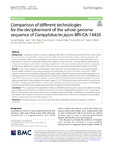2019-12-16Zeitschriftenartikel
Comparison of diferent technologies for the decipherment of the whole genome sequence of Campylobacter jejuni BfR-CA-14430
Epping, Lennard
Golz, Julia C.
Knüver, Marie‑Theres
Huber, Charlotte
Thürmer, Andrea
Wieler, Lothar H.
Stingl, Kerstin
Semmler, Torsten
Background: Campylobacter jejuni is a zoonotic pathogen that infects the human gut through the food chain mainly
by consumption of undercooked chicken meat, raw chicken cross-contaminated ready-to-eat food or by raw milk.
In the last decades, C. jejuni has increasingly become the most common bacterial cause for food-born infections in
high income countries, costing public health systems billions of euros each year. Currently, diferent whole genome
sequencing techniques such as short-read bridge amplifcation and long-read single molecule real-time sequencing
techniques are applied for in-depth analysis of bacterial species, in particular, Illumina MiSeq, PacBio and MinION.
Results: In this study, we analyzed a recently isolated C. jejuni strain from chicken meat by short- and long-read data from
Illumina, PacBio and MinION sequencing technologies. For comparability, this strain is used in the German PAC-CAMPY
research consortium in several studies, including phenotypic analysis of bioflm formation, natural transformation and in vivo
colonization models. The complete assembled genome sequence most likely consists of a chromosome of 1,645,980 bp cov‑
ering 1665 coding sequences as well as a plasmid sequence with 41,772 bp that encodes for 46 genes. Multilocus sequence
typing revealed that the strain belongs to the clonal complex CC-21 (ST-44) which is known to be involved in C. jejuni human
infections, including outbreaks. Furthermore, we discovered resistance determinants and a point mutation in the DNA gyrase
(gyrA) that render the bacterium resistant against ampicillin, tetracycline and (fuoro-)quinolones.
Conclusion: The comparison of Illumina MiSeq, PacBio and MinION sequencing and analyses with diferent assembly
tools enabled us to reconstruct a complete chromosome as well as a circular plasmid sequence of the C. jejuni strain
BfR-CA-14430. Illumina short-read sequencing in combination with either PacBio or MinION can substantially improve
the quality of the complete chromosome and epichromosomal elements on the level of mismatches and insertions/
deletions, depending on the assembly program used.
Dateien zu dieser Publikation

